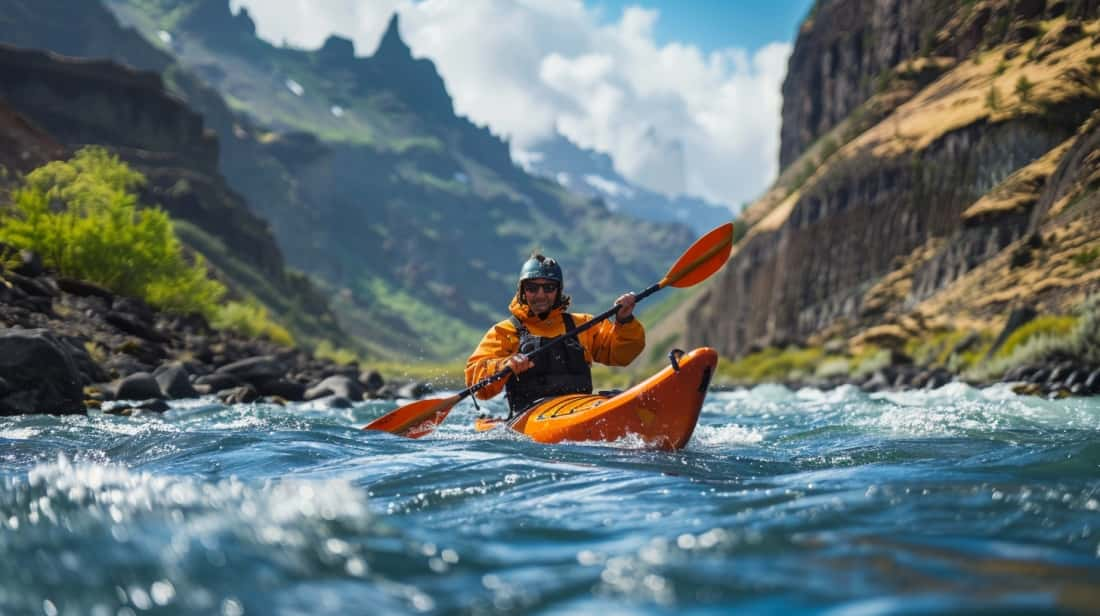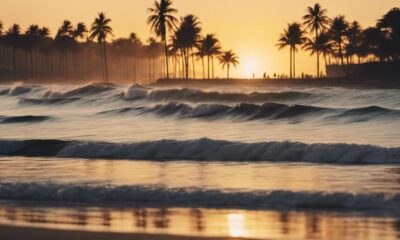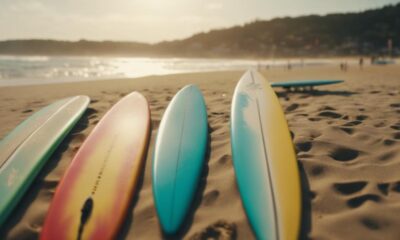Surfing Waves
River Surfing: How to Make a River Surfing Wave
Transform your river into a surfing paradise with expert tips and design secrets that will keep you riding the waves all day long!
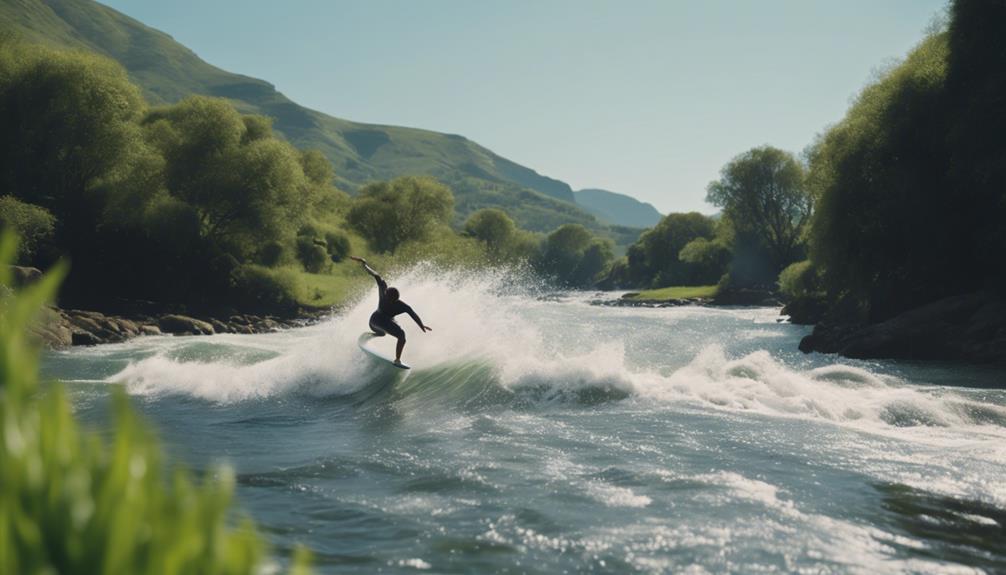
To create a river surfing wave, you need to manipulate water flow and channel design effectively. First, locate a low head dam where you can enhance the gradient and flow rate. You'll want to dig channels using sand shovels to shape the water into surfable waves. Maintain specific flow rates for wave stability and engage local experts to navigate any regulatory hurdles. Don't forget safety gear, like helmets and life jackets. Understanding the types of waves—like perpendicular and A-frame—helps you select the best fit for your surfing style. There's so much more to explore in the world of river surfing!
Key Takeaways
- Select a suitable site near a low head dam to create ideal wave conditions through hydraulic jumps and controlled water flow.
- Use sand shovels and teamwork to modify river channels, enhancing wave formation while maintaining environmental sustainability.
- Ensure safety by wearing protective gear and assessing local hazards, including debris and seasonal flooding risks before surfing.
- Conduct Environmental Impact Assessments to minimize disruption to local wildlife and preserve river ecosystems during wave construction.
Understanding River Wave Mechanics
Understanding river wave mechanics involves grasping how water flow interacts with channel geometry to create surfable standing waves.
When you're out there looking for river waves, it's essential to know that the flow rate and water level dictate the wave's shape and stability. The best surfable wave, known as the maximum wave, requires precise calculations of both the flow and channel features. Without these calculations, you risk creating unstable waves that aren't safe for surfing.
To enhance wave stability, many setups utilize a wave shaper. This movable device adapts to changing water conditions, ensuring the wave remains consistent despite variations in flow and depth. You'll notice that standing waves can appear in different forms, like perpendicular or A-frame waves, each offering unique surfing experiences.
Artificial river waves, such as those created in projects like the Riverwave in Austria, often involve diverting water into specially designed channels to achieve ideal wave conditions. By understanding these mechanics, you can better appreciate the intricacies behind the perfect river wave and enjoy your surfing experience more fully.
Essential Tools for Wave Creation
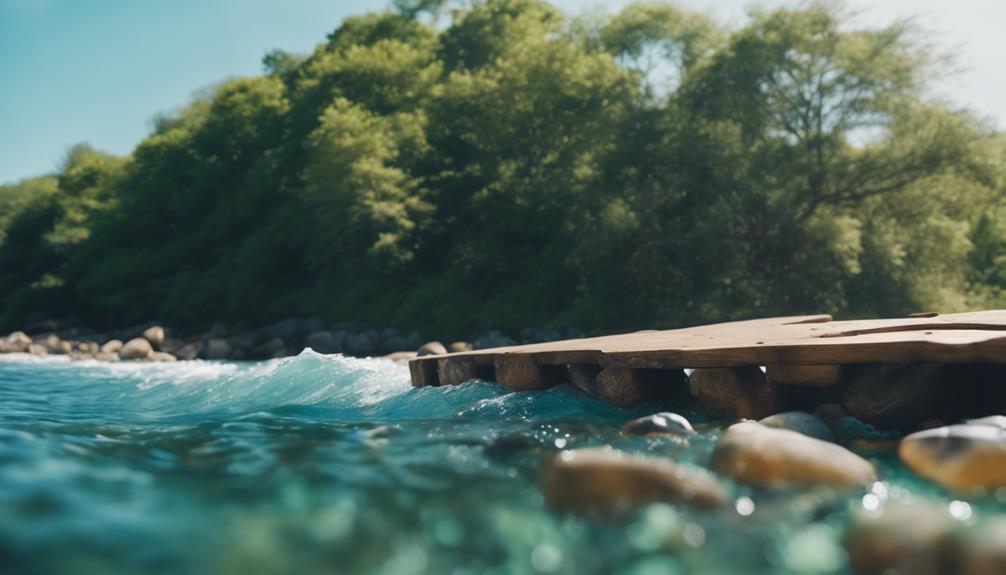
Creating a river surfing wave requires specific tools and teamwork to modify the riverbed effectively. To form the perfect river wave, you'll need a few essential tools. Gathering a group of friends can make the process quicker and safer. Here's a quick overview of what you'll need:
| Tool | Purpose | Notes |
|---|---|---|
| Sand Shovels | Digging channels | Perfect for shaping the bed |
| Surfboards | Riding the wave | Choose boards suited for river conditions |
| Safety Gear | Protecting against debris and erosion | Helmets and life jackets recommended |
Using sand shovels, you can dig channels to enhance wave formation, especially during heavy rains when the river floods. It might take about three hours to create a good channel, so teamwork is key. Once you've shaped the riverbed, grab your surfboards and hit the waves! Just make sure you understand local river conditions, as safety's a priority. Enjoy the ride and be mindful of the risks that debris and erosion can pose during your wave creation adventure!
Step-by-Step Wave Construction
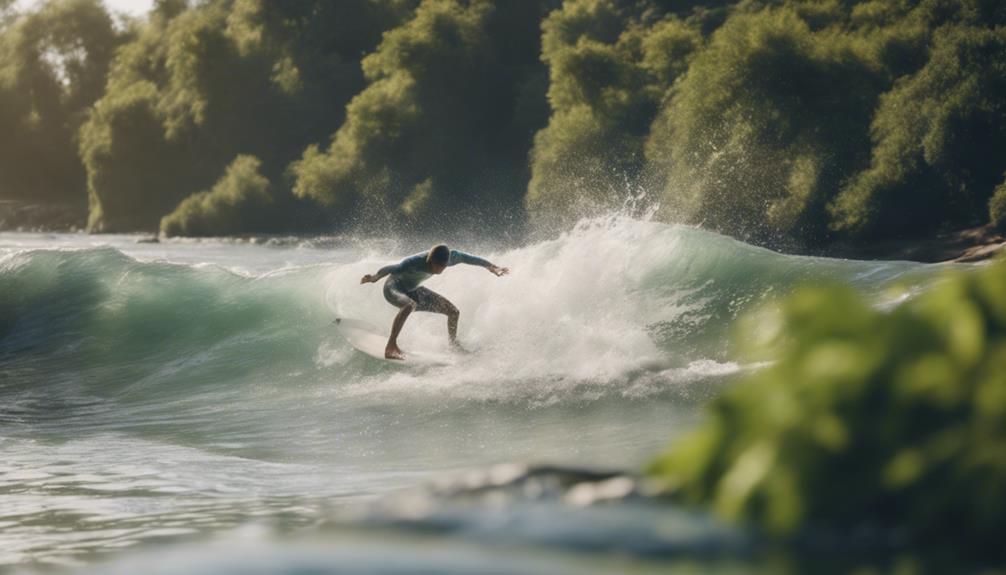
When you're ready to construct your river wave, start by choosing the right site that features a low head dam to create that essential water gradient.
Next, you'll need to employ various wave construction techniques, such as using kicker plates, to shape the wave effectively.
Site Selection Criteria
Selecting the right site for a river surfing wave involves careful consideration of factors like gradient, flow rate, and community accessibility. To guarantee you create an ideal environment for a surfable wave, follow these key criteria:
- Gradient and Flow Rate: Look for a site with a low head dam that offers the necessary gradient and flow rate. Successful whitewater parks in Colorado exemplify how these factors contribute to an excellent surfing experience.
- Accessibility: Choose a location that's easily accessible to local population centers. This not only enhances community engagement but also boosts potential visitor turnout, making the wave project more sustainable.
- Environmental and Regulatory Compliance: Conduct initial site evaluations to assess the environmental impacts. Make certain compliance with local regulations before moving forward with engineering plans, and collaborate with local river or park groups to gather support for your initiative.
Wave Construction Techniques
Identifying the right techniques for wave construction at your chosen site is essential to achieving a surfable and sustainable river wave. Start by selecting an ideal location, typically near a low head dam, where the river gradient can create hydraulic jumps essential for wave formation.
Next, utilize effective wave construction techniques. Divert the water into a canal, then create elevation changes that will help generate those surfable waves. Pay attention to wave formation mechanics, ensuring specific flow rates and water levels are maintained. A movable wave shaper can enhance the wave's stability and shape.
Choose from various artificial wave designs, such as perpendicular or A-frame waves, depending on the surfing experience you want to provide. Throughout the construction, engage local experts and stakeholders to navigate regulatory challenges and maintain ecological balance.
Here's a quick reference table for your wave construction process:
| Step | Description |
|---|---|
| Site Selection | Identify a location near low head dam |
| Water Diversion | Divert water into a canal |
| Elevation Changes | Create changes to generate waves |
| Maintain Flow Rates | Control flow rates and water levels |
| Choose Wave Design | Select design based on desired experience |
Safety Considerations for Surfers
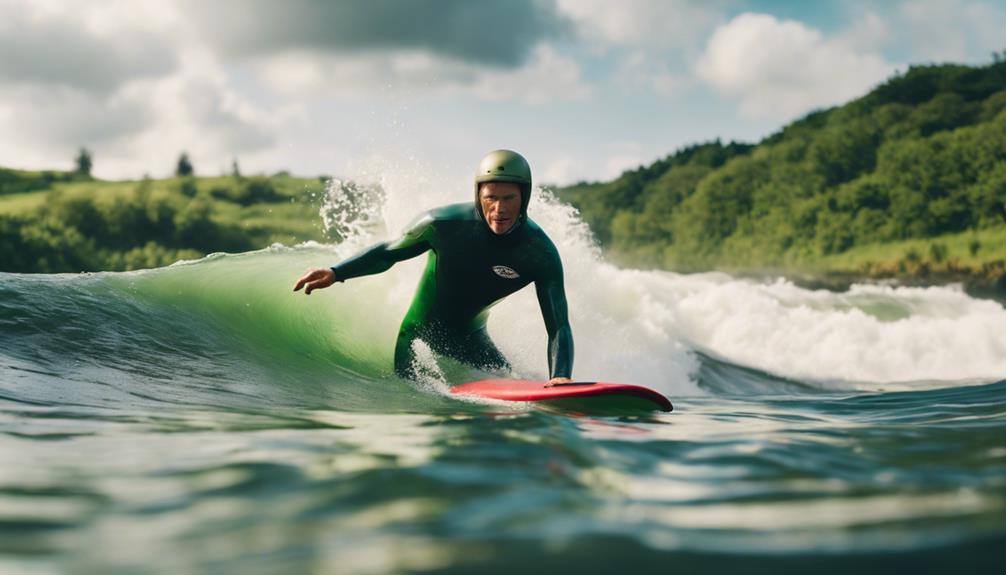
Before hitting the river, you should carefully assess the water for debris and hazards that could pose serious risks while surfing. Heavy rains can wash in large objects like logs and rocks, which can lead to dangerous situations. Always stay aware of the river's conditions and seasonal flooding patterns to guarantee your safety while river surfing.
Here are three essential safety considerations to keep in mind:
- Wear Safety Gear: Equip yourself with a helmet and impact vest. These items can greatly reduce injury risks from falls or collisions.
- Stay Away from Eroded Edges: Erosion can make the edges of the channel unstable. Keep a safe distance from these areas to avoid accidents.
- Engage with Local Surfers: Connect with experienced surfers in the area. They can share valuable insights about local hazards and safety measures specific to the river.
Environmental Impact Assessment
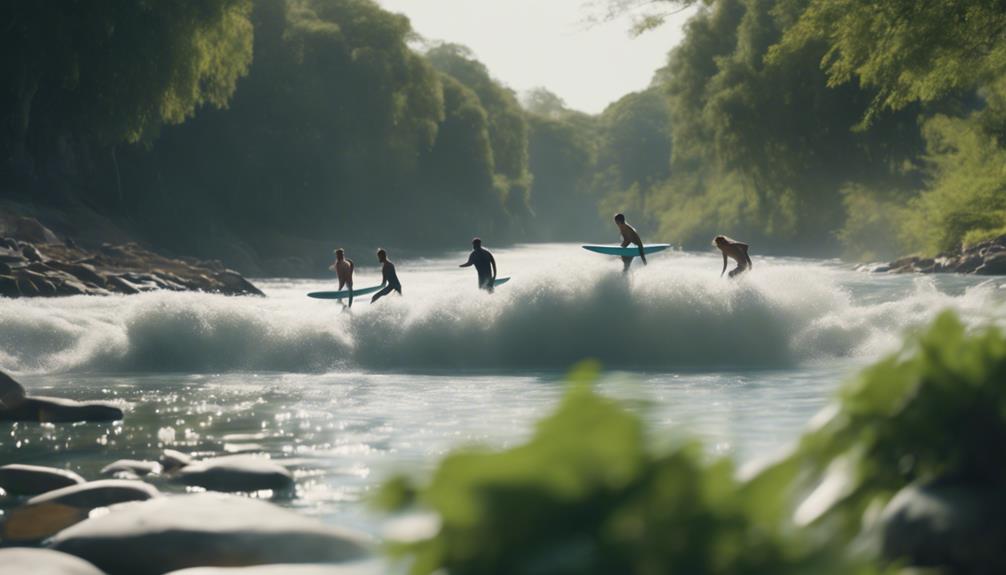
When creating artificial river waves, you've got to reflect on how it might disrupt local wildlife habitats.
It's vital to contemplate strategies for preserving these habitats while enjoying the thrill of river surfing.
Balancing recreational activities with environmental health helps protect the ecosystems that depend on these rivers.
Wildlife Disruption Considerations
Creating waves in rivers can considerably disrupt local wildlife habitats, impacting fish and aquatic species by altering their natural environments. It's vital to reflect on the ecological consequences of such activities, particularly as they relate to wildlife disruption.
Here are three key factors to keep in mind:
- Erosion Effects: Excavating riverbanks to create waves can lead to significant erosion, destabilizing ecosystems and affecting plant life that supports fish and other aquatic species.
- Breeding Grounds: Changes in water flow may disrupt fish breeding and spawning cycles, putting pressure on local fish populations and altering seasonal migrations.
- Debris Risks: Heavy rains can exacerbate river flooding, carrying debris that poses risks to both surfers and wildlife, complicating the already fragile ecological balance.
Conservationists stress the importance of conducting thorough environmental assessments. Understanding how wave creation impacts local wildlife is vital for balancing recreational enjoyment with the preservation of river health.
Habitat Preservation Strategies
Conducting an Environmental Impact Assessment (EIA) is crucial for guaranteeing that the creation of artificial river waves doesn't harm local wildlife and their habitats. Before you set out to build a surfing wave, evaluate potential disruptions to aquatic species, especially fish populations, to verify they won't be negatively impacted.
Your assessment should also address the risk of erosion and habitat loss due to channel modifications. These changes can affect not just the fish but also plant life and the overall health of river ecosystems.
Partnering with local environmental organizations can help you strike a balance between creating exciting whitewater parks for surfers and the fundamental need for habitat preservation.
Additionally, educating the community about ecological balance and sustainable practices is critical. When everyone understands the importance of protecting local habitats, responsible participation in river surfing can flourish.
Not only will this guarantee the longevity of the wave you create, but it will also protect the environment for future generations. By prioritizing these strategies, you'll contribute to a thriving ecosystem that benefits both surfers and wildlife alike.
Types of River Surfing Waves
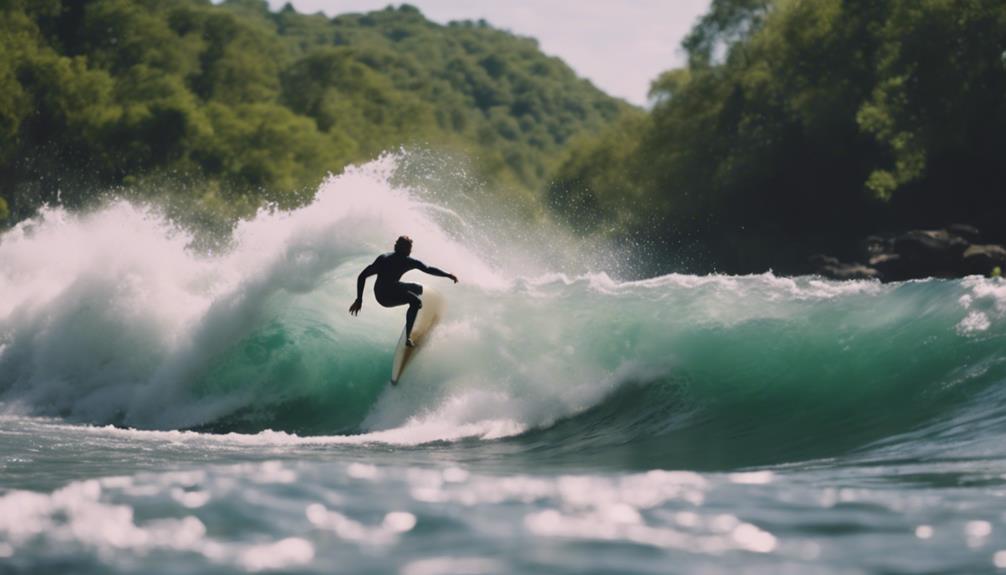
Exploring the various types of river surfing waves reveals unique characteristics that cater to different surfing styles and skill levels. Each type of wave offers distinct experiences, helping you choose the best fit for your preferences.
Here are three key types of river surfing waves:
- Perpendicular Waves: These are the most common type of wave, breaking parallel to the river flow. They provide a consistent ride, making them ideal for surfers of all levels.
- A-frame Waves: Symmetrical in nature, A-frame waves offer balanced left and right sides. This versatility accommodates diverse surfing preferences, allowing you to practice your skills on both sides.
- Bowl Waves: Featuring mirrored contours with higher centers, bowl waves present an exciting challenge. While they remain largely undeveloped at full scale, they hold potential for unique surfing experiences that can elevate your skills.
Community Involvement and Support
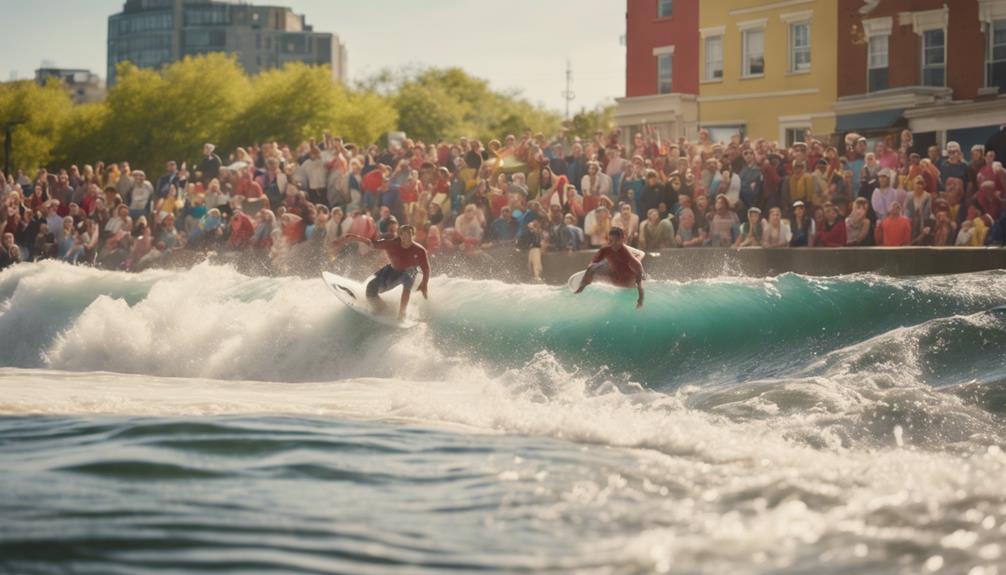
Engaging the community is essential for the success of river surfing projects, as local support can provide critical resources and advocacy. You need to rally the community around the initiative and demonstrate its benefits, like boosting tourism and enhancing recreational opportunities. Local government involvement from the beginning is fundamental; it helps you secure funding, permits, and political backing, which can greatly impact your project's viability.
To visualize the key aspects of community involvement and support, consider the following table:
| Aspect | Importance |
|---|---|
| Local Groups | Provide resources and advocacy for the initiative. |
| Local Government | Essential for obtaining funding, permits, and political support. |
| Community Interest Base | Demonstrates public demand, sustaining momentum through development. |
Future Trends in River Surfing
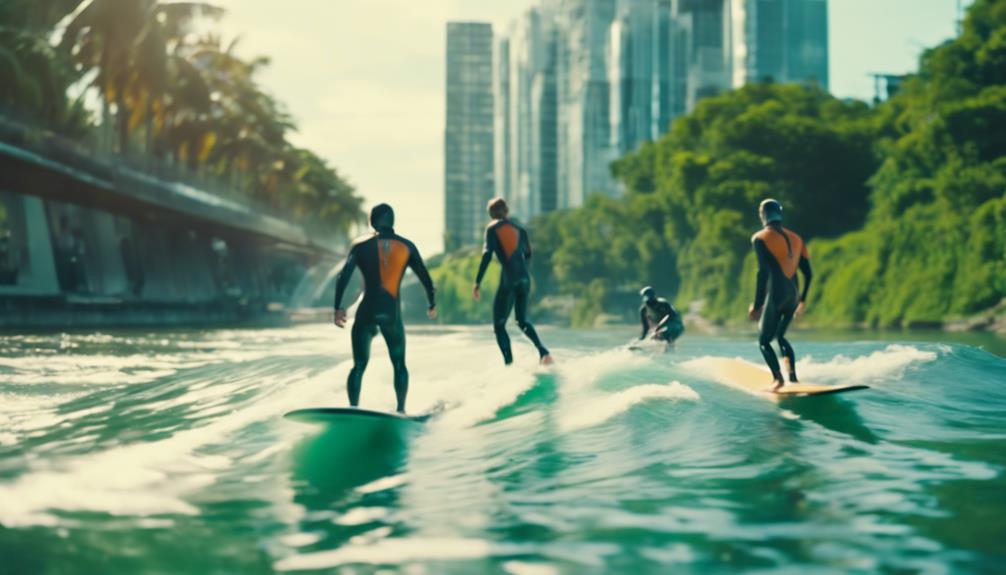
As community support grows, the future of river surfing is set to evolve with exciting innovations in wave technology and design. You can expect a transformation in how waves are created and experienced, thanks to ongoing research and development.
Here are three key trends to watch:
- 3D Wave Structures: The shift from traditional 2D waves to innovative 3D designs will enhance your surfing experience, allowing for skill progression and versatility in maneuvers.
- Kicker Plates: These advancements in wave channels represent a leap forward in creating ocean-like wave forms for river surfing, possibly outperforming natural formations you may currently ride.
- Diverse Wave Types: With the introduction of various artificial wave designs—such as bowl, oblique, and A-frame—you're bound to find unique surfing environments that cater to different styles and preferences.
As river surfing gains traction, the construction of more Whitewater Parks will likely follow. These parks won't only promote local economies but also create opportunities for competitive surfing, making it possible for you to train in non-ocean locations and even aim for Olympic-level performance.
Frequently Asked Questions
Is It Legal to Make a River Wave?
It depends on local laws and regulations. You'll need to check with local authorities and possibly get permits. Always consider the environmental impact and collaborate with conservationists to guarantee you're following legal guidelines.
How to Catch a River Wave?
Catching a enthralling current requires careful consideration. Approach at an angle, assess the features, and paddle with purpose. Find the sweet spot, maintain your stance, and practice patiently to perfect your river wave riding skills.
How Is a River Wave Formed?
A river wave forms when water flows over an obstruction, creating a hydraulic jump. Factors like flow rate and riverbed structure influence the wave's size and shape, making each wave unique and dynamic.
How to Make an Artificial Wave?
'Where there's a will, there's a way.' To make an artificial wave, you'll need to engineer riverbed structures, control flow rates, and design specific wave forms for ideal surfing experiences. Embrace creativity and experimentation!
Can the Techniques for Drawing Surfing Waves be Applied to Creating River Surfing Waves?
When learning how to draw waves in surfing, the techniques can be applied to creating river surfing waves. Understanding the movement and shape of ocean waves can help designers mimic natural wave formations in river environments, creating an exciting and authentic surfing experience for river surfers.
Conclusion
In the end, creating a river surfing wave is like crafting a masterpiece—every detail matters.
As you ride the currents of innovation and nature's rhythm, remember to respect the river's spirit, much like the ancient surfers who revered the ocean's power.
By blending your passion with community support and environmental care, you're not just catching waves; you're shaping the very essence of river surfing for generations to come.
So grab your board and ride into this thrilling adventure!
Surfing Waves
Dive Into Adventure: 7 Unique Water-Based Activities Unveiled

Are you ready to make a splash beyond traditional water parks? Discover a world of thrilling aquatic adventures that will get your adrenaline pumping and create unforgettable memories. From underwater museums to bioluminescent bay kayaking, we’ve compiled a list of seven unique water-based activities that will quench your thirst for excitement.
1. Underwater Exploration: Scuba Diving and Snorkeling
Dive into the depths of the ocean and explore vibrant coral reefs teeming with marine life. Whether you’re a beginner or an experienced diver, there’s an underwater adventure waiting for you.
Best Locations for Beginners:
- Key Largo, Florida
- Cozumel, Mexico
- Great Barrier Reef, Australia
Advanced Diving Experiences:
- Blue Hole, Belize
- Silfra Fissure, Iceland
- Palau, Micronesia
Before embarking on your underwater adventure, make sure to get proper training and certification. Always prioritize safety and follow local guidelines.
2. Thrilling Water Sports: Beyond the Basics
Take your water adventures to the next level with these exhilarating sports that combine skill, balance, and adrenaline.

Kiteboarding and Windsurfing:
Harness the power of wind and waves as you glide across the water’s surface. Popular destinations include:
- Maui, Hawaii
- Tarifa, Spain
- Cabarete, Dominican Republic
Whitewater Rafting and Kayaking:
Navigate through rushing rapids and experience the thrill of conquering wild rivers. Top locations include:
- Colorado River, Grand Canyon
- Zambezi River, Zimbabwe
- Futaleufú River, Chile
Popular Water Sports Destinations
3. Unique Aquatic Experiences
Dive into these one-of-a-kind water-based activities that combine art, nature, and adventure.
Underwater Museums and Sculpture Parks:
Explore submerged art installations that double as artificial reefs, supporting marine life while providing a unique diving experience.
- MUSA (Museo Subacuático de Arte), Mexico
- Molinere Underwater Sculpture Park, Grenada
- The Underwater Museum of Marseille, France
Bioluminescent Bay Kayaking:
Paddle through waters that glow with bioluminescent microorganisms, creating a magical nighttime experience.
- Mosquito Bay, Vieques, Puerto Rico
- Luminous Lagoon, Jamaica
- Jervis Bay, Australia
Ice Diving in Frozen Lakes:
For the truly adventurous, explore the serene underwater world of frozen lakes and witness unique ice formations.
- Lake Baikal, Russia
- Plansee, Austria
- Morrison’s Quarry, Canada
Underwater Museums
MUSA in Mexico has over 500 sculptures, covering 420,000 sq ft
Bioluminescent Bay Kayaking
Mosquito Bay’s organisms produce 1,000 times more light than a firefly
Ice Diving in Frozen Lakes
Lake Baikal’s ice diving season: January to April, -2°C to 4°C
4. Eco-Friendly Water Adventures
Combine your love for water activities with environmental conservation efforts.
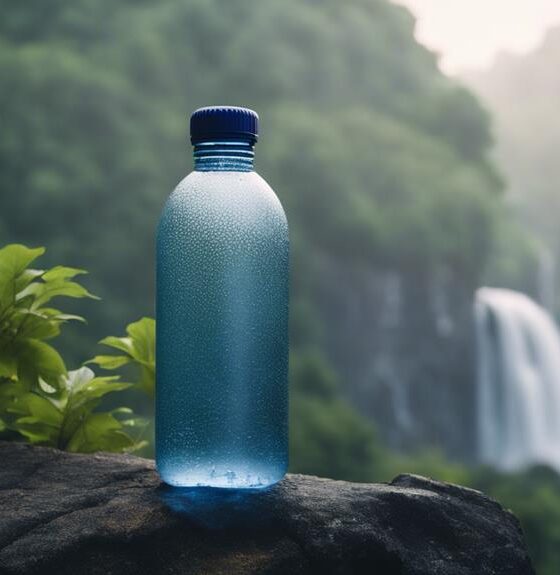
Swimming with Marine Life Responsibly:
Interact with gentle giants of the sea while following responsible wildlife tourism practices.
- Whale sharks in Isla Holbox, Mexico
- Manatees in Crystal River, Florida
- Dolphins in Kaikoura, New Zealand
Coral Reef Restoration Programs:
Participate in hands-on conservation efforts to protect and restore fragile coral ecosystems.
- Coral Restoration Foundation, Florida Keys
- Great Barrier Reef Marine Park Authority, Australia
- Gili Eco Trust, Indonesia
Eco-Friendly Water Adventure Tips
- Reduce Plastic Waste: 8 million tons of plastic waste enter oceans yearly. Bring reusable water bottles and gear.
- Respect Marine Life: 75% of coral reefs are threatened. Never touch or stand on coral reefs.
- Conserve Water: Average person uses 80-100 gallons daily. Take shorter showers and turn off taps when not in use.
- Support Sustainable Tourism: Choose tour operators with eco-certifications and responsible practices.
- Learn About Local Ecosystems: 75% of fish populations are overfished. Support local conservation efforts and education programs.
Planning Your Unique Water-Based Adventure
Before diving into your next aquatic adventure, consider these essential tips:
- Research the best seasons for your chosen activity
- Invest in proper gear and equipment
- Choose reputable tour operators and guides
- Consider travel insurance that covers water-based activities
- Respect local customs and environmental regulations
For more water park tips and guides, visit All Waterparks’ Water Park Tips & Guides section.
What Water-Based Activities in Queenstown Can I Try With the Best Jet Boat?
When in Queenstown, don’t miss out on the exhilarating water-based activities. Take a ride on the best jet boat in queenstown and experience the thrill of speeding across the water, maneuvering through narrow canyons, and performing adrenaline-pumping spins and turns. It’s a must-try for adventure seekers!
Conclusion: Dive Into Your Next Adventure
From exploring underwater museums to kayaking in bioluminescent bays, these unique water-based activities offer unforgettable experiences for adventure seekers. Whether you’re a seasoned water enthusiast or looking to dip your toes into something new, there’s an aquatic adventure waiting for you.
Remember to always prioritize safety, respect the environment, and embrace the thrill of discovering new water-based activities. So grab your swimsuit, pack your sense of adventure, and get ready to make a splash in ways you never imagined!
For more inspiration on water-based fun, check out All Waterparks’ Best Water Parks and Indoor Water Parks sections. The world of water adventures awaits – dive in and explore!
Surfing Waves
Iconic Breaks: Most Famous Surfing Waves
Adventure awaits as you explore the world's most iconic surfing breaks, each promising unforgettable challenges and breathtaking experiences that will leave you yearning for more.

If you're chasing the thrill of surfing iconic waves, you can't miss Pipeline in Oahu, known for its powerful, hollow barrels. Teahupo'o in Tahiti challenges even the most seasoned surfers with its massive waves crashing over sharp reefs. Mavericks in California delivers bone-chilling, towering swells that draw the best competitors. Then there's Nazaré in Portugal, famous for monstrous waves that can exceed 100 feet! Each spot offers distinct characteristics that define the surfing experience. By exploring these legendary breaks, you'll discover what makes each unique and the culture that surrounds them.
Key Takeaways
- Pipeline in Oahu is renowned for its powerful, hollow waves and hosts the prestigious Pipeline Masters competition every December.
- Teahupo'o in Tahiti is famous for being the heaviest wave, breaking over sharp coral reefs and often exceeding 30 feet.
- Mavericks in California features cold, powerful waves ranging from 25 to 50 feet and is home to elite surf competitions.
- Nazaré in Portugal produces some of the largest waves globally, reaching up to 100 feet due to its unique underwater canyon.
Overview of Iconic Surf Breaks
When it comes to iconic surf breaks, you'll find some of the most thrilling waves in the world, each offering unique challenges and experiences for surfers.
Pipeline in Oahu, Hawaii, is a must-visit for any surfer. Known for its powerful, hollow waves, it hosts the prestigious Pipeline Masters competition every December, attracting elite surfers enthusiastic to conquer its famous barrels.
Teahupo'o in Tahiti is another beast altogether, recognized as one of the heaviest waves globally. The wave breaks over a razor-sharp coral reef, producing waves that can exceed 30 feet, making it a magnet for big-wave surfers.
Mavericks, near Half Moon Bay, California, is infamous for its cold, powerful waves that can reach heights between 25 and 50 feet during winter swells. This surf break is home to the Mavericks Surf Contest, where only the bravest compete.
In Nazaré, Portugal, Praia do Norte produces some of the largest waves in the world, sometimes reaching up to 100 feet, thanks to its unique underwater canyon.
Top Big Wave Surfing Locations

Exploring the top big wave surfing locations reveals some of the most exhilarating and challenging spots that every adrenaline-seeking surfer should experience.
Nazaré in Portugal is famous for its colossal waves, reaching up to 100 feet, thanks to its unique underwater canyon. If you're looking for powerful swells, Jaws (Peahi) in Maui, Hawaii, is a must-visit, with waves exceeding 60 feet during winter swells, especially since the rise of tow surfing in the 1990s.
Teahupo'o in Tahiti holds the title of the 'Heaviest Wave in the World,' featuring thick, hollow waves over sharp reefs, often exceeding 30 feet. Mavericks, located near Half Moon Bay in California, is known for cold, powerful waves reaching 25 to 50 feet, making it one of the best surf spots for elite surfers and hosting thrilling competitions.
Finally, don't overlook Cortes Bank, a submerged island off California's coast, infamous for treacherous conditions and record-breaking waves that can soar over 75 feet.
These top big wave surfing locations are where you'll find some of the most famous waves on the planet.
Unique Features of Each Break
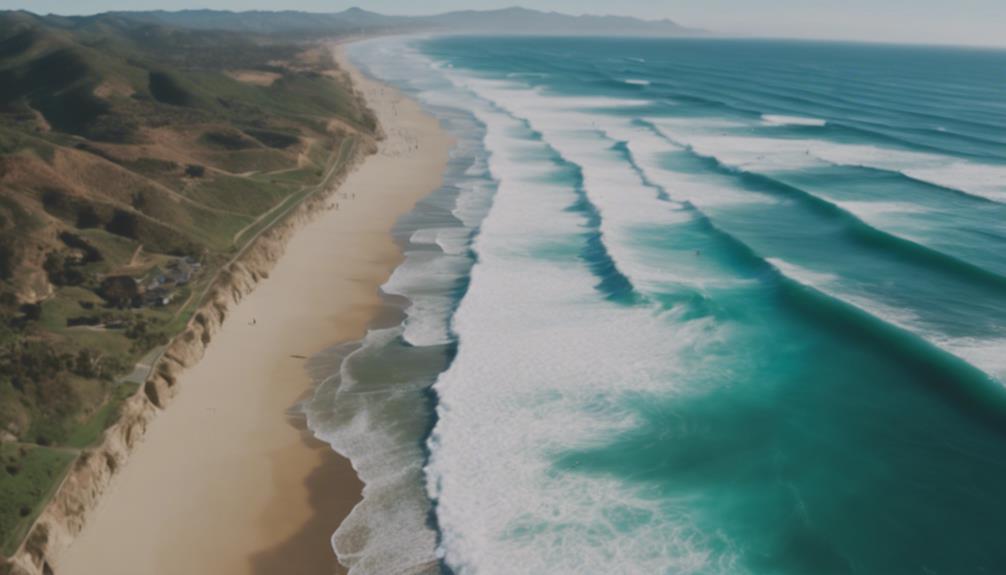
What makes each surfing break unique lies in its distinct wave characteristics and the challenges they present to surfers.
Teahupo'o, known as 'The Heaviest Wave in the World,' features thick, heavy waves that crash over a shallow reef, making it a formidable spot for even seasoned surfers.
On Maui, Jaws delivers powerful waves that can exceed 60 feet, drawing elite surfers enthusiastic to tackle its fierce conditions.
In Nazaré, Portugal, the unique underwater canyon enhances wave formations, allowing for some of the largest surfable waves in the world, sometimes reaching up to 100 feet.
Mavericks in California showcases cold, powerful waves that challenge surfers with heights of 25 to 50 feet, often hosting the intense Mavericks Surf Contest.
Lastly, Pipeline in Oahu, Hawaii, stands out as the ultimate surfing destination, featuring hollow waves that create perfect barrels. This spot not only attracts competitive surfers but also holds a cherished place in the surf community.
Each of these breaks offers unique features that make them iconic, inviting surfers to confront their power and embrace the thrill.
Safety and Preparation Essentials

To tackle the challenges of big wave surfing safely, it's essential to prepare thoroughly and equip yourself with the right gear and knowledge. Big-wave surfer Mark Foo emphasized the importance of preparation for big wave surfing, which includes selecting appropriate gear like a shortboard, wetsuit, and safety equipment.
Given the extreme conditions you'll face, having a jet ski or boat support is critical, especially at offshore breaks, to assist in paddling into the waves and guaranteeing a safe return.
You also need to develop strong decision-making skills regarding whether to paddle into waves or tow into them, as this can greatly impact your safety and performance. Continuous training and mental preparation are crucial for managing the physical and emotional toll of surfing in high-risk environments.
Familiarizing yourself with safety protocols, such as buddy systems and emergency procedures, will help mitigate risks associated with potential injuries or fatalities.
Before heading to your chosen surfing spot, make sure you've honed these skills and have the right support system in place. Being prepared isn't just about gear; it's about being ready for whatever the ocean throws your way.
Surfing Culture and Community Impact

Surfing culture thrives on the connections among surfers, shaping local identities and fostering a deep sense of community wherever waves break. Each iconic break, from Pipeline to Teahupo'o, embodies unique traditions, such as the Aloha spirit in Hawaii or California's laid-back vibe. Surf schools play an essential role, making surfing accessible to newcomers while boosting local economies through tourism.
Surfing events, like the Eddie Aikau Competition at Waimea Bay, highlight the camaraderie among local communities and international competitors. These gatherings celebrate not only the sport but also the shared passion that unites surfers of all backgrounds. The emotional highs and lows of these events emphasize the importance of respect for the ocean and each other within the professional culture.
As surfing continues to evolve, its community impact remains significant. The stories and experiences shared at iconic breaks create bonds that transcend borders, inspiring new generations to embrace the ocean. By fostering a culture rooted in respect and connection, surfing nurtures a vibrant community that thrives on the waves, ensuring that the spirit of the sport lives on for years to come.
Frequently Asked Questions
What Is the Most Famous Surf Break?
When you think about the most famous surf break, Pipeline in Hawaii often comes to mind. Its incredible waves, thrilling challenges, and vibrant surf culture draw surfers and spectators from around the world year after year.
What Is the Name of the Legendary Surf Break?
You might call it Pipeline, a legendary surf break known for its powerful waves. Surfers flock to its shores, ready to tackle the thrilling challenges it presents, making it an unforgettable destination for wave riders.
Where Is the Biggest Surf Break in the World?
Did you know waves at Praia do Norte in Nazaré can reach heights of up to 100 feet? This stunning surf break in Portugal is recognized as the biggest in the world, attracting thrill-seeking surfers globally.
What Is the Famous Surf Break in Spain?
If you're looking for famous surf breaks in Spain, Mundaka's your spot. Its heavy left-hand tube and powerful waves attract elite surfers, especially during autumn swells, making it a must-visit for any surf enthusiast.
Are the Most Famous Surfing Waves Also the Longest in the World?
The longest surfing waves worldwide are not necessarily the most famous. While spots like Waimea Bay and Pipeline in Hawaii are renowned for their epic waves, lesser-known locations like Chicama in Peru and Coxos in Portugal offer some of the longest rides in the world.
Conclusion
In conclusion, surfing's spectacular spots serve up thrilling challenges and unforgettable experiences.
Whether you're chasing colossal waves or craving cozy breaks, each iconic location offers its own charm and community.
So, grab your gear, gather your gang, and get ready to ride the rippling rhythm of the sea.
Embrace the essence of these enchanting waves, and let the ocean's endless energy elevate your surfing adventure to exhilarating heights!
Surfing Waves
Global Danger: Most Dangerous Surfing Waves in the World
You won't believe the treacherous surfing waves that await in the world's most dangerous spots; discover the risks that could change your life forever.

If you're looking for the most dangerous surfing waves in the world, you should be aware of spots like Pipeline, Teahupoo, and Mavericks. Pipeline is infamous for its shallow reefs and has caused seven fatalities since 1989. Teahupoo's fierce waves challenge even experts, while Mavericks draws thrill-seekers with its colossal swells. Puerto Escondido's heavy surf can be deadly, and Waimea Bay has a tragic history of accidents. Each location presents unique risks, and it's vital to respect the ocean. You may find that there's more to uncover about these thrilling but perilous surfing spots.
Key Takeaways
- Dangerous surfing waves like Pipeline, Teahupoo, and Mavericks present serious risks, including fatalities and severe injuries due to their extreme conditions.
- Pipeline, Hawaii is known as the deadliest wave, with seven recorded fatalities since 1989, primarily due to shallow reefs and strong currents.
- Teahupoo in Tahiti features powerful waves amplified by a reef structure, resulting in five fatalities since 2000, highlighting the importance of respect for the ocean.
- Puerto Escondido, Mexico is notorious for heavy surf and strong currents, posing life-threatening risks even to experienced surfers, with recent fatalities reported.
Overview of Dangerous Surfing Waves
Dangerous surfing waves pose serious risks to surfers, challenging even the most skilled riders with their powerful forces and unpredictable nature. Big wave surfing attracts thrill-seekers who often underestimate the dangers that come with these monstrous waves. Locations like Teahupoo in Tahiti and Mavericks in California showcase extreme wave dynamics that can lead to significant risk of injury.
Surfers face perilous conditions, from heavy waves crashing onto unforgiving reefs to strong currents that can pull even experienced riders underwater. Each wave presents a unique challenge, and the stakes are high. The risk of injury is ever-present, with wipeouts resulting in serious consequences, including drowning or severe trauma.
As you navigate these dangerous waves, it's crucial to respect the ocean's power and understand the inherent risks involved. Areas like Puerto Escondido and Dungeons in South Africa are notorious for their heavy surf, adding another layer of danger. Knowing the conditions and preparing adequately can make a difference, but no amount of skill can fully eliminate the risks associated with big wave surfing.
Always prioritize safety and approach these waves with caution.
Pipeline, Hawaii: The Deadliest Wave

When you think of surfing dangers, Pipeline in Hawaii stands out with its deadly reputation.
With seven fatalities since 1989 and numerous incidents like Evan Geiselman's close call, the risks are real.
Surfers need to be aware of the shallow reefs and strong currents that make this wave both a challenge and a threat.
Notable Fatalities and Incidents
Pipeline, Hawaii, stands notorious for its treacherous waves, having claimed seven lives since 1989. This location is infamous for its notable fatalities, including Andy Chuda in 1989 and Travis Mussleman in 2000. Both surfers fell victim to the dangers posed by Pipeline's powerful waves, which can easily overwhelm even the most experienced surfers.
The risks at Pipeline are amplified by its shallow reef, which lies just beneath the surface. During big swells, the waves crash violently, creating a perilous environment for those attempting to ride them. The sheer force of these tubular formations can lead to severe injuries or worse. Many surfers underestimate the wave's power, believing that skill alone will keep them safe.
Despite the tragic history, surfers continue flocking to Pipeline, drawn by its challenge and allure. The beach remains a testing ground where ambition and danger collide. You must respect these waters and acknowledge the risks involved, as many have learned too late that Pipeline isn't just a surfing spot—it's a reflection of nature's might. Always prioritize safety and be aware of the inherent dangers when tackling this iconic wave.
Surfer Rescues and Risks
Surfers face immense risks at Pipeline, where the powerful waves and shallow reefs can turn a thrilling ride into a life-threatening situation in an instant. Known as the deadliest wave globally, Pipeline has recorded seven fatalities since 1989, underscoring the inherent danger of surfing here. While the adrenaline rush is undeniable, the risks are real.
Here are three key dangers surfers encounter at Pipeline:
- Wipeouts: Surfers often hit the ocean bed during wipeouts, risking severe injuries.
- Coral Reefs: The shallow water and sharp reefs can lead to dangerous impacts, making rescues more essential.
- High-Impact Waves: The wave's tubular formation creates a powerful force that can easily overwhelm even experienced surfers.
Notable rescues, like Evan Geiselman's in December 2015, highlight the urgent need for safety measures.
Despite the high stakes, surfers are drawn to Pipeline's allure, showcasing their courage and determination. However, it's vital to prioritize awareness and preparedness to navigate the dangers that come with surfing this iconic wave.
Teahupoo, Tahiti: A Reef Nightmare

When you think about Teahupoo, the sheer power and intensity of its waves immediately come to mind.
This spot has seen its share of notable incidents, reminding you of the real dangers lurking beneath the surface.
Local surfers know the risks all too well, employing unique practices to navigate this notorious reef safely.
Wave Power and Intensity
Teahupoo's waves release a ferocious intensity, transforming a seemingly calm ocean into a deadly spectacle that challenges even the most skilled surfers. Known for its heavy water, this spot embodies the concept of wave power like no other. Its unique reef structure amplifies swells, turning them into some of the most dangerous waves in the surfing world.
When you consider tackling Teahupoo, keep these factors in mind:
- Wave Dynamics: The semi-circular reef shape creates explosive breaks that can catch you off guard.
- Wipeouts: Even experienced surfers can face devastating wipeouts due to the shallow reef, leading to serious injuries.
- Fatal Risks: With five recorded deaths since 2000, the risks are real and demand respect.
Despite the dangers, the allure of riding such powerful waves attracts elite surfers from around the globe. However, knowing the intensity and risks involved is essential for anyone daring enough to challenge Teahupoo's infamous waves.
The combination of beauty and peril makes this location a true nightmare for the unprepared.
Notable Incidents and Rescues
The perilous nature of Teahupoo has led to numerous notable incidents and daring rescues, underscoring the wave's deadly reputation. Known as one of the most dangerous waves in the world, Teahupoo presents extreme risks that even seasoned surfers struggle to navigate.
Since 2000, five fatalities have occurred here, with Briece Taere's tragic death in 2001 serving as a stark reminder of the dangers associated with wipeouts into the shallow reef.
In 2015, Niccolo Porcella faced a near-fatal wipeout that was described as violently intense, illustrating the unpredictable nature of big-wave surfing at this location. Despite the waves rarely exceeding 10 feet, their power can be overwhelming, leading to significant injuries.
The unique dynamics of Teahupoo, where the semi-circular reef and ocean swell create waves that seem to 'suck up' the water, add to the challenge. Surfers tackling these extreme conditions often rely on quick-thinking friends and lifeguards for rescue, highlighting the camaraderie and risk inherent in big-wave surfing.
At Teahupoo, every ride can be both thrilling and perilous, demanding respect for the ocean's might.
Local Surfer Practices
Local surfers at Teahupoo embrace the challenge of its treacherous waves, honing their skills while maneuvering the risks of the shallow reef. The Tahitian surf community thrives on the adrenaline that comes with riding these dangerous waves, pushing themselves to master the extreme conditions.
Here's how they prepare:
- Training: Local surfers engage in rigorous physical training, focusing on strength and endurance to withstand the powerful swells.
- Equipment: They invest in specialized boards designed for the unique demands of Teahupoo, ensuring they can handle the intense forces of the waves.
- Safety Protocols: Surfers establish buddy systems and spotters to monitor each other, enhancing safety during rides and minimizing risks.
Despite the perilous nature of Teahupoo, the local surfers respect the ocean's power and understand the importance of preparation. They know that every session can be unpredictable, and the reef holds its dangers.
Puerto Escondido, Mexico: Heavy Risks

Puerto Escondido, Mexico, draws surfers with its breathtaking waves, but the dangers lurking beneath the surface can be life-threatening. Known for its heavy waves and unpredictable conditions, this spot has claimed the lives of surfers like Ron Cassidy, Noel Robinson, and Jay Adams in recent years. Even experienced surfers can find themselves overwhelmed by the powerful waves that crash onto the shores.
Despite improved lifeguard services, the risks remain high, especially during large swells. Surfers must be acutely aware of the dangerous conditions, as they can change rapidly. Mark Healey has voiced his doubts about surviving some of the most treacherous waves here, highlighting the unpredictability of the ocean.
Many surfers, including Makua Rothman, have shared harrowing tales of being pulled underwater by the sheer force of the waves. If you're planning to surf in Puerto Escondido, it's essential to respect the power of the ocean.
Only take on these heavy waves if you're well-prepared and experienced, because what looks like a thrilling ride can quickly turn into a perilous situation.
Waimea Bay, Hawaii: A History of Tragedy

Waimea Bay, Hawaii, has a long and tragic history that rivals the dangers found in Puerto Escondido, with its powerful waves claiming numerous lives since 1943.
Surfers flock to this iconic spot, drawn by its allure, but the risks are undeniable. Over the decades, several incidents have solidified Waimea Bay's reputation as one of the most dangerous surf locations in the world, leading to numerous fatalities.
Here are three notable tragedies that highlight the dangers:
- Dickie Cross (1943) – This surfer went missing while riding the treacherous waves, marking one of the first major incidents in Waimea's history.
- Donnie Solomon (1995) – His death reinforced the perilous nature of the bay, serving as a stark reminder for fellow surfers.
- Alec Ace Coole (2015) – He vanished while surfing, and despite extensive search efforts, he was never found, emphasizing the risks involved.
Surfers at Waimea Bay often embody a culture of caution, aware of the powerful waves and the tragic history that looms over this stunning yet dangerous surf haven.
Mavericks, California: Thrills and Perils

Mavericks in California is famous for its colossal waves, drawing surfers enthusiastic for both thrills and the inherent dangers that come with them. Waves can reach heights of 25 feet, with reports of some exceeding 80 feet under ideal conditions. The shallow reef creates dramatic impacts, making it a high-risk location.
Many professional surfers have faced the perilous conditions, and notable incidents have led to tragic losses, including the deaths of Mark Foo and Sion Milosky. Cold water and strong currents add to the hazards, prompting experts to call for better safety gear. You need to be aware of the risks before paddling out into these powerful waves.
Here's a quick overview of the dangers associated with Mavericks:
| Aspect | Details |
|---|---|
| Wave Height | Up to 80 feet |
| Water Temp | Cold water, around 50°F (10°C) |
| Risk Factors | Shallow reef, strong currents |
| Incidents | Deaths of Mark Foo and Sion Milosky |
| Surfer Type | Professional surfers |
Mavericks remains a thrilling yet dangerous challenge for those who seek the ultimate big wave experience.
Unique Waves Around the World

Beyond the challenges of Mavericks, surfers around the globe encounter a variety of unique waves that offer their own thrilling yet dangerous experiences. These waves aren't just any swells; they're some of the most dangerous waves on the planet. Here are three that stand out:
- Teahupoo, Tahiti: Known as the heaviest wave in the world, Teahupoo's semi-circular reef creates powerful swells that demand respect. Surfers have faced severe consequences here, with five recorded deaths since 2000.
- Dungeons, Cape Town, South Africa: With massive swells reaching up to 70 feet, Dungeons is notorious for its perilous conditions, including being situated in shark-infested waters. This adds an extra layer of danger for any daring surfer.
- Shipstern Bluff, Tasmania: Dubbed the 'wave at the end of the world,' Shipstern Bluff features complex formations and 'stair steps' that can reach 25 feet. It's a challenge even for the most experienced surfers.
Each of these unique waves presents not only excitement but also significant risks, making them unforgettable challenges for anyone brave enough to ride them.
Safety Measures for Surfers
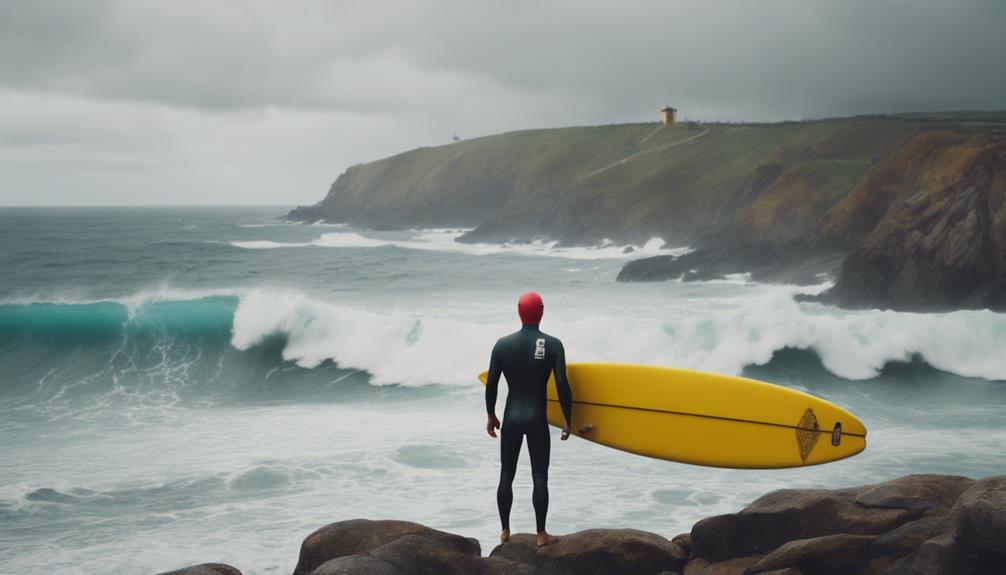
When hitting the waves, it's vital to prioritize safety by understanding your skill level and choosing appropriate surf spots. Always assess your personal skill level before paddling out; this helps reduce the risk of accidents. Opt for waves that match your abilities and avoid pushing your limits in dangerous conditions.
Familiarize yourself with local conditions by observing the beach and sea for at least 30 minutes before you enter the water. This observation will help you spot potential hazards like rip currents or submerged rocks. Make sure you have the appropriate safety equipment, such as a leash, life vest, and wetsuit, to protect yourself against injuries or cold water.
It's also critical to surf with a buddy or in a group. Having someone nearby can provide immediate assistance in case of emergencies.
Finally, stay informed about weather conditions. Changes in weather can greatly affect wave dynamics and safety, so always check forecasts before heading out.
Frequently Asked Questions
Where Is the Most Dangerous Wave to Surf?
If you're looking for the most dangerous wave to surf, Pipeline in Hawaii's your top choice. Its powerful waves and shallow reefs create a lethal mix, claiming lives and challenging even the bravest surfers.
Where Are the Roughest Waves in the World?
Did you know that waves at Mavericks can exceed 80 feet? When searching for the roughest waves in the world, consider Pipeline, Teahupoo, and Shipstern Bluff, each presenting unique and perilous challenges for surfers like you.
What Is the Most Dangerous Ocean for Waves?
The most dangerous ocean for waves is the Pacific. Its powerful swells and extreme conditions create notorious surf spots like Pipeline and Teahupoo, where surfers face significant risks and must respect the ocean's unpredictable nature.
Are the Waves at Nazaré Dangerous?
You wouldn't want to test the waters at Nazaré unless you're ready for a wild ride. The waves are exceptionally dangerous, with their massive heights and unpredictable conditions challenging even the most skilled surfers.
What Makes These Surfing Waves So Dangerous?
The deadliest surfing wave worldwide is known for its immense size and unpredictable behavior. Its powerful currents and sharp reef make it a formidable challenge for even the most experienced surfers. The wave’s reputation for causing severe injuries and even fatalities adds to its dangerous allure for adrenaline-seeking thrill-seekers.
Conclusion
Surfing isn't just a thrilling ride; it's a dance with danger.
As you paddle out to these infamous waves, remember that each swell holds its own unpredictable challenges.
From the treacherous reefs of Teahupoo to the monstrous barrels of Pipeline, respect the ocean's power.
Like a lion lurking in the grass, these waves can strike when you least expect it.
Stay informed, stay cautious, and let your passion for surfing guide you through the exhilarating waters of risk.
-
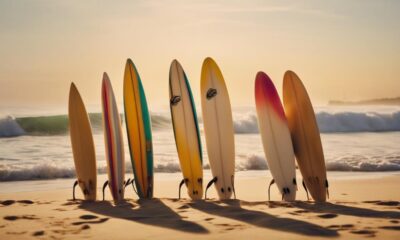
 Vetted5 months ago
Vetted5 months ago15 Best Surfboards of 2025: Ride the Waves Like a Pro
-

 Beach Body5 months ago
Beach Body5 months agoGlow Safely With Top Tanning Sunscreens
-

 Beach Body5 months ago
Beach Body5 months agoMaximize Your Glow Before Vacation
-

 Beach Body5 months ago
Beach Body5 months agoWhat Is the Beach Body Total Solution Pack? Find Out!
-

 Vetted5 months ago
Vetted5 months ago15 Best Surfing Pikachu V Cards That Every Collector Needs in Their Deck
-

 Vetted5 months ago
Vetted5 months ago14 Best Surfing Books to Inspire Your Next Wave Adventure
-
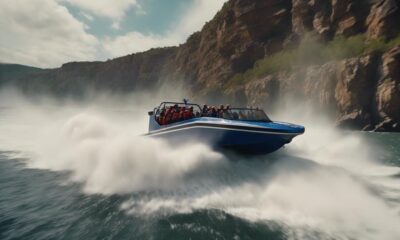
 Jet Boat5 months ago
Jet Boat5 months agoAre Jet Boats Dangerous? What You Need to Watch Out For!
-

 Surfing Waves5 months ago
Surfing Waves5 months agoDive Into Adventure: 7 Unique Water-Based Activities Unveiled


